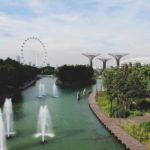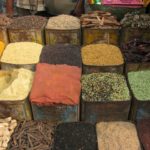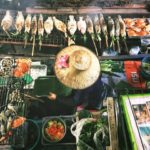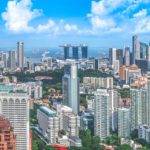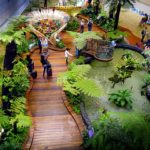A Walk Around Singapore’s Ethnic Neighborhoods

Organized, efficient and squeaky clean, the Switzerland of Asia is a small island nation that packs a lot of punch into its neat and tidy borders. In a country where littering, jaywalking and forgetting to flush the toilet can incur hefty fines, the sense of cleanliness and discipline is palpable. Yet, despite its order, Singapore is not sanitized and sterile. Instead, it is colorful and vibrant and culturally diverse. Singapore’s ethnic neighborhoods and world-class modern architecture give the city a feeling of being both forward-thinking and modern, yet also deeply rooted in its multi-layered history.
During my 24 hour visit to the city, I set out to walk around Singapore’s culturally vibrant neighborhoods and discover the pockets of nature within its bustling urban core.
In 1963, the country’s founding Prime Minister, Lee Kuan Yew, envisioned a green city where trees and abundant flora would soften the harshness of the asphalt jungle and give Singapore the sense of being a “City in a Garden.” As the country continues to urbanize, the commitment to ensuring the city’s streets remain green has not wavered. And today, amongst the urban jungle of skyscrapers and apartment buildings, a natural jungle of plants and wildlife flourishes.
A Walk Around Singapore’s Ethnic Neighborhoods.
My first stop was the sprawling MacRitchie Park. Together with a new friend I met at my hostel, I walked the forest trails and admired the green sea of treetops from the park’s swinging bridges. We hiked through the forested paths, listening to the chirping birds and watching the macaques swing from the trees above us.
From the heart of MacRitchie Park, it was easy to forget that we were in one of Asia’s largest economic and industrial powerhouses.
After finding refuge in the dense forest of MacRitchie Park, I parted ways with my companion and began my self-guided walking tour around Singapore’s ethnic neighborhoods. My first stop was the colorful enclave of Little India.
Walking the streets of Little India gave me a glimpse into the culture of one of Singapore’s largest immigrant districts. Temples adorned with Hindu Gods and demons rise above the picturesque houses and women mill about in saris. The neighborhood’s buildings are colorful and the scent of herbs and spices fills the air.
In the hour I spent wandering around Little India, I sat down for a plate of tandoori chicken, photographed the picturesque buildings, ogled at the gaudy statues of Sri Srinivasa Perumal and somehow completely skipped out on the famous Sri Veeramakaliamman.
Then, sweaty, grimy and exhausted from the heat, I stopped by my hostel for a quick break before continuing toward the Muslim neighborhood of Kampong Glam.
In the early 19th century, the colorful, predominantly Muslim district of Kampong Glam became home to the Singapore’s Malay aristocracy. It attracted traders from Middle Eastern countries and grew into a diverse and multicultural Muslim community, containing a blend of Malay, Indonesian and Arab populations.
Today, the area is an aesthetically pleasing and culturally vibrant district, with its rows of textile shops, curry houses and the imposing Sultan Mosque.
From Kampong Glam, I headed toward Chinatown. As its name suggests, Chinatown is a historically Chinese neighborhood. It is chockfull of Buddhist temples and Daoist shrines.
Chinatown, more than any other area of Singapore, illustrates the city’s multiculturalism. It is the perfect example of how Singapore’s diverse cultures and religions lie side by side in peace. For, though the area is best known for its Chinese influence, it is home to a sprinkling of mosques and Hindu temples as well. Within a two block span, I saw the colorful sculptures of Sri Mariamman, the minaret of the Jamae Mosque and the upswept roof of the Buddha Tooth Relic Temple.
As the heat of the afternoon began to subside, I left Singapore’s ethnic neighborhoods and found myself walking toward the iconic Gardens by the Bay via Boat Quay–an area that was once the economic heart of Singapore. Much like the Bund in Shanghai, the architecture around Boat Quay is a testament to the city’s deeply entrenched colonial history.
My walk led me to the mouth of the Singapore River, along a promenade that extends from Boat Quay to the heart of Singapore. The promenade affords views of British colonial buildings and the iconic Marina Bay Sands Hotel in the distance.
I made my way toward the waterfront gardens, ogling at the iconic structure and watching the lights flicker on, one by one.
The Gardens by the Bay are a perfect representation of Lee Kuan Yew’s vision of integrating nature into urban areas and transforming Singapore from a city with abundant parks to a “City in a Garden.”
The horticultural wonderland spans over one hundred hectares of reclaimed land. Its tree-shaped vertical gardens are a dazzling display of brilliant lights and tangled vines.
While visitors can enjoy areal views of the gardens by purchasing tickets for the elevated walkways, I chose to skip out on the experience. Instead, I laid down on a bench looking up–allowing myself to become fully absorbed by the visual and auditory display of music and lights.
Despite my short visit to Singapore, I could immediately see that the small city-state has its eyes set on the future.
A walk around Singapore’s ethnic neighborhoods reveals a city that is rooted in its multi-ethnic past, while being modern, cosmopolitan, sustainable and forward-thinking. And just as the city embraces its multicultural heritage in an increasingly globalized world, so too is it successful in finding a balance between green spaces and urbanization and between progress and preservation.
This post first appeared on the author’s blog, Erika’s Travels. Photo by Pixabay.


